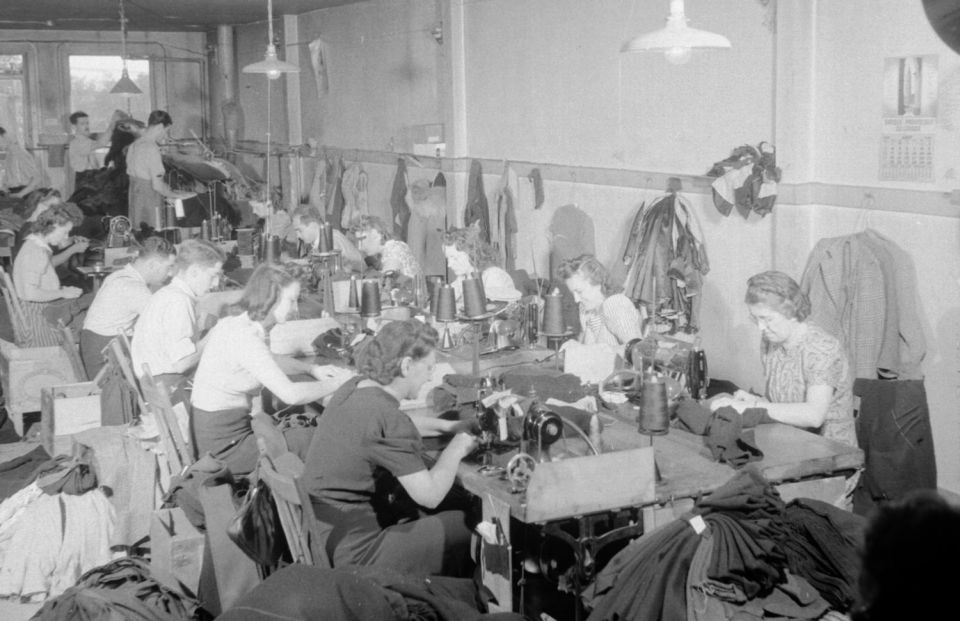
Clothing industry
Clothing industry or garment industry summarizes the types of trade and industry along the production and value chain of clothing and garments, starting with the textile industry (producers of cotton, wool, fur, and synthetic fibre), embellishment using embroidery, via the fashion industry to apparel retailers up to trade with second-hand clothes and textile recycling. The producing sectors build upon a wealth of clothing technology some of which, like the loom, the cotton gin, and the sewing machine heralded industrialization not only of the previous textile manufacturing practices. Clothing industries are also known as allied industries, fashion industries, garment industries, or soft goods industries.
"Rag trade" redirects here. For the racehorse, see Rag Trade (horse). For the television series, see The Rag Trade.Accord on Fire and Building Safety in Bangladesh
Alliance for Bangladesh Worker Safety
Fashion industry
Fashion design services
List of fabric names
List of textile fibres
Nylon riots
Savile Row tailoring
Shoemaking
Sweatshop
Tailor
Textile
Textile industry
(proposed US amendment to the Fair Labor Standards Act of 1938, introduced May 2022)
The FABRIC Act
Uniforms
Carpenter, Jesse Thomas. Competition and Collective Bargaining in the Needle Trades, 1910-67 (Cornell UP, 1972).
Chandler, Alfred The Visible Hand: The Managerial Revolution in American Business (Harvard UP, 1977), pp 287, 289, 298, 308–09, 312.
Cherington, Paul T. The Wool Industry: Commercial Problems of the American Woolen and Worsted Manufacture (1917)
online
Cole, Arthur H. "A neglected chapter in the history of combinations: The American wool manufacture." Quarterly Journal of Economics 37.3 (1923): 436–475.
Copeland, Melvin Thomas. The cotton manufacturing industry of the United States (Harvard UP, 1912) .
online
Corbin, Harry A. The Men's Clothing Industry: Colonial Times Through Modern Times (New York, 1970).
Fraser, Steve. Labor will rule: Sidney Hillman and the rise of American labor (Cornell UP, 1993) head of .
Amalgamated Clothing Workers of America
Godley, Andrew. Jewish immigrant entrepreneurship in New York and London 1880–1914. (Palgrave Macmillan, 2001).
Goldstein, Gabriel M. and Elizabeth Greenberg, eds. A Perfect Fit: The Garment Industry and American Jewry (1860–1960) (Texas Tech UP, 2012), heavily illustrated
Green, Nancy L. Ready-to-wear and ready-to-work: a century of industry and immigrants in Paris and New York (Duke UP, 1997).
Haberland, Michelle. "Striking Beauties: Women Apparel Workers in the United States South, 1930-2000" (University of Georgia Press, 2015).
Hapke, Laura. Sweatshop: the history of an American idea (Rutgers UP, 2004).
Joselit, Jenna Weissman. A Perfect Fit: Clothes, Character, and the Promise of America (2002).
Katz, Daniel. All together different: Yiddish socialists, garment workers, and the labor roots of multiculturalism (NYU Press, 2011).
Liebhold, Peter, and Harry R. Rubenstein. Between a rock and a hard place: A history of American sweatshops, 1820-present (UCLA Asian American Studies Center, 1999).
Nystrom, Paul. The Economics of Fashion (New York, 1928).
Parmet, Robert D. The Master of Seventh Avenue The Master of Seventh Avenue David Dubinsky and the American Labor Movement (2012), head of the (ILGWU)
International Ladies' Garment Workers' Union
Pastorello, Karen. A power among them: Bessie Abramowitz Hillman and the making of the Amalgamated Clothing Workers of America (U of Illinois Press, 2008).
Pope, Eliphalet. The Clothing Industry in New York (U of Missouri, 1905)
online
Popkin, Martin E. Organization, Management, and Technology in the Manufacture of Men's Clothing (New York, 1929)
Seidman, Joel. The Needle Trades (1942)
Tyson, Thomas. "Collective bargaining and cost accounting: the case of the US men's clothing industry", Accounting and Business Research 25.97 (1994): 23–38.